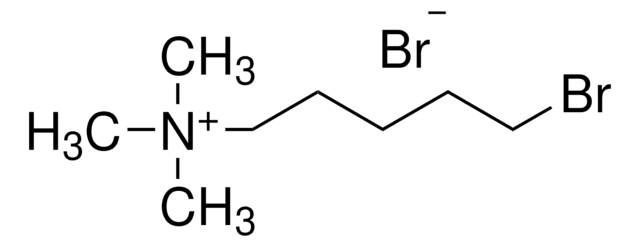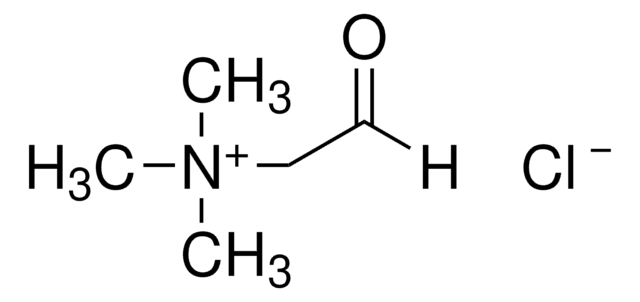50053
Cloruro de glicidiltrimetilamonio
technical, ≥90% (calc. based on dry substance, AT)
Sinónimos:
Cloruro de (2,3-epoxipropil)trimetilamonio
About This Item
Productos recomendados
grade
technical
Quality Level
assay
≥90% (calc. based on dry substance, AT)
impurities
2-4% chlorohydrin
20-25% water
density
1.13 g/mL at 20 °C (lit.)
storage temp.
2-8°C
SMILES string
[Cl-].C[N+](C)(C)CC1CO1
InChI
1S/C6H14NO.ClH/c1-7(2,3)4-6-5-8-6;/h6H,4-5H2,1-3H3;1H/q+1;/p-1
InChI key
PUVAFTRIIUSGLK-UHFFFAOYSA-M
¿Está buscando productos similares? Visita Guía de comparación de productos
General description
Application
Caution
Related product
signalword
Danger
Hazard Classifications
Acute Tox. 4 Dermal - Acute Tox. 4 Inhalation - Acute Tox. 4 Oral - Aquatic Chronic 3 - Carc. 1B - Eye Dam. 1 - Muta. 2 - Repr. 1B - Skin Sens. 1 - STOT RE 2 - STOT SE 2
target_organs
Kidney
Storage Class
6.1C - Combustible acute toxic Cat.3 / toxic compounds or compounds which causing chronic effects
wgk_germany
WGK 3
flash_point_f
338.0 °F - closed cup
flash_point_c
170 °C - closed cup
ppe
Eyeshields, Faceshields, Gloves, type P3 (EN 143) respirator cartridges
Certificados de análisis (COA)
Busque Certificados de análisis (COA) introduciendo el número de lote del producto. Los números de lote se encuentran en la etiqueta del producto después de las palabras «Lot» o «Batch»
¿Ya tiene este producto?
Encuentre la documentación para los productos que ha comprado recientemente en la Biblioteca de documentos.
Los clientes también vieron
Nuestro equipo de científicos tiene experiencia en todas las áreas de investigación: Ciencias de la vida, Ciencia de los materiales, Síntesis química, Cromatografía, Analítica y muchas otras.
Póngase en contacto con el Servicio técnico

![[2-(Acryloyloxy)ethyl]trimethylammonium chloride solution 80 wt. % in H2O, contains 600 ppm monomethyl ether hydroquinone as inhibitor](/deepweb/assets/sigmaaldrich/product/structures/393/326/f7e19585-5431-4220-81b5-f458de6d63d0/640/f7e19585-5431-4220-81b5-f458de6d63d0.png)




![[2-(Methacryloyloxy)ethyl]trimethylammonium chloride solution 75 wt. % in H2O](/deepweb/assets/sigmaaldrich/product/structures/316/612/66b0f4cf-d060-427d-b4f5-e8fab3e5cffe/640/66b0f4cf-d060-427d-b4f5-e8fab3e5cffe.png)








